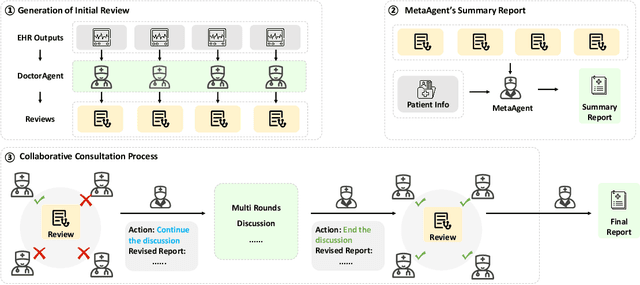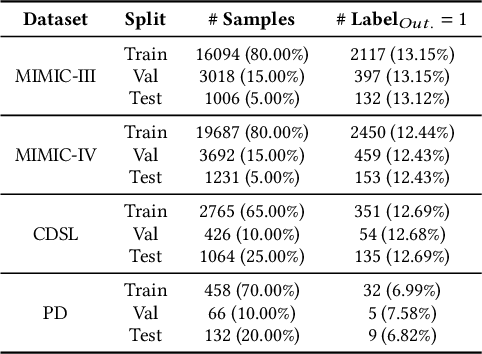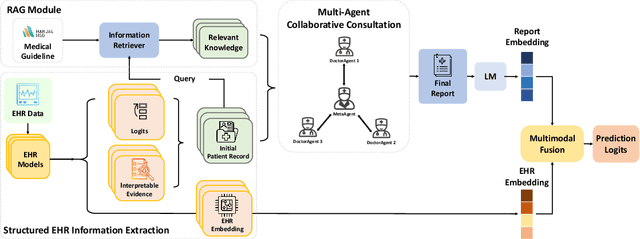Junyi Gao
TrialPanorama: Database and Benchmark for Systematic Review and Design of Clinical Trials
May 22, 2025Abstract:Developing artificial intelligence (AI) for vertical domains requires a solid data foundation for both training and evaluation. In this work, we introduce TrialPanorama, a large-scale, structured database comprising 1,657,476 clinical trial records aggregated from 15 global sources. The database captures key aspects of trial design and execution, including trial setups, interventions, conditions, biomarkers, and outcomes, and links them to standard biomedical ontologies such as DrugBank and MedDRA. This structured and ontology-grounded design enables TrialPanorama to serve as a unified, extensible resource for a wide range of clinical trial tasks, including trial planning, design, and summarization. To demonstrate its utility, we derive a suite of benchmark tasks directly from the TrialPanorama database. The benchmark spans eight tasks across two categories: three for systematic review (study search, study screening, and evidence summarization) and five for trial design (arm design, eligibility criteria, endpoint selection, sample size estimation, and trial completion assessment). The experiments using five state-of-the-art large language models (LLMs) show that while general-purpose LLMs exhibit some zero-shot capability, their performance is still inadequate for high-stakes clinical trial workflows. We release TrialPanorama database and the benchmark to facilitate further research on AI for clinical trials.
MedAgentBoard: Benchmarking Multi-Agent Collaboration with Conventional Methods for Diverse Medical Tasks
May 18, 2025Abstract:The rapid advancement of Large Language Models (LLMs) has stimulated interest in multi-agent collaboration for addressing complex medical tasks. However, the practical advantages of multi-agent collaboration approaches remain insufficiently understood. Existing evaluations often lack generalizability, failing to cover diverse tasks reflective of real-world clinical practice, and frequently omit rigorous comparisons against both single-LLM-based and established conventional methods. To address this critical gap, we introduce MedAgentBoard, a comprehensive benchmark for the systematic evaluation of multi-agent collaboration, single-LLM, and conventional approaches. MedAgentBoard encompasses four diverse medical task categories: (1) medical (visual) question answering, (2) lay summary generation, (3) structured Electronic Health Record (EHR) predictive modeling, and (4) clinical workflow automation, across text, medical images, and structured EHR data. Our extensive experiments reveal a nuanced landscape: while multi-agent collaboration demonstrates benefits in specific scenarios, such as enhancing task completeness in clinical workflow automation, it does not consistently outperform advanced single LLMs (e.g., in textual medical QA) or, critically, specialized conventional methods that generally maintain better performance in tasks like medical VQA and EHR-based prediction. MedAgentBoard offers a vital resource and actionable insights, emphasizing the necessity of a task-specific, evidence-based approach to selecting and developing AI solutions in medicine. It underscores that the inherent complexity and overhead of multi-agent collaboration must be carefully weighed against tangible performance gains. All code, datasets, detailed prompts, and experimental results are open-sourced at https://medagentboard.netlify.app/.
InformGen: An AI Copilot for Accurate and Compliant Clinical Research Consent Document Generation
Apr 01, 2025Abstract:Leveraging large language models (LLMs) to generate high-stakes documents, such as informed consent forms (ICFs), remains a significant challenge due to the extreme need for regulatory compliance and factual accuracy. Here, we present InformGen, an LLM-driven copilot for accurate and compliant ICF drafting by optimized knowledge document parsing and content generation, with humans in the loop. We further construct a benchmark dataset comprising protocols and ICFs from 900 clinical trials. Experimental results demonstrate that InformGen achieves near 100% compliance with 18 core regulatory rules derived from FDA guidelines, outperforming a vanilla GPT-4o model by up to 30%. Additionally, a user study with five annotators shows that InformGen, when integrated with manual intervention, attains over 90% factual accuracy, significantly surpassing the vanilla GPT-4o model's 57%-82%. Crucially, InformGen ensures traceability by providing inline citations to source protocols, enabling easy verification and maintaining the highest standards of factual integrity.
ColaCare: Enhancing Electronic Health Record Modeling through Large Language Model-Driven Multi-Agent Collaboration
Oct 03, 2024



Abstract:We introduce ColaCare, a framework that enhances Electronic Health Record (EHR) modeling through multi-agent collaboration driven by Large Language Models (LLMs). Our approach seamlessly integrates domain-specific expert models with LLMs to bridge the gap between structured EHR data and text-based reasoning. Inspired by clinical consultations, ColaCare employs two types of agents: DoctorAgent and MetaAgent, which collaboratively analyze patient data. Expert models process and generate predictions from numerical EHR data, while LLM agents produce reasoning references and decision-making reports within the collaborative consultation framework. We additionally incorporate the Merck Manual of Diagnosis and Therapy (MSD) medical guideline within a retrieval-augmented generation (RAG) module for authoritative evidence support. Extensive experiments conducted on four distinct EHR datasets demonstrate ColaCare's superior performance in mortality prediction tasks, underscoring its potential to revolutionize clinical decision support systems and advance personalized precision medicine. The code, complete prompt templates, more case studies, etc. are publicly available at the anonymous link: https://colacare.netlify.app.
Is larger always better? Evaluating and prompting large language models for non-generative medical tasks
Jul 26, 2024Abstract:The use of Large Language Models (LLMs) in medicine is growing, but their ability to handle both structured Electronic Health Record (EHR) data and unstructured clinical notes is not well-studied. This study benchmarks various models, including GPT-based LLMs, BERT-based models, and traditional clinical predictive models, for non-generative medical tasks utilizing renowned datasets. We assessed 14 language models (9 GPT-based and 5 BERT-based) and 7 traditional predictive models using the MIMIC dataset (ICU patient records) and the TJH dataset (early COVID-19 EHR data), focusing on tasks such as mortality and readmission prediction, disease hierarchy reconstruction, and biomedical sentence matching, comparing both zero-shot and finetuned performance. Results indicated that LLMs exhibited robust zero-shot predictive capabilities on structured EHR data when using well-designed prompting strategies, frequently surpassing traditional models. However, for unstructured medical texts, LLMs did not outperform finetuned BERT models, which excelled in both supervised and unsupervised tasks. Consequently, while LLMs are effective for zero-shot learning on structured data, finetuned BERT models are more suitable for unstructured texts, underscoring the importance of selecting models based on specific task requirements and data characteristics to optimize the application of NLP technology in healthcare.
Adaptive Activation Steering: A Tuning-Free LLM Truthfulness Improvement Method for Diverse Hallucinations Categories
May 26, 2024Abstract:Recent studies have indicated that Large Language Models (LLMs) harbor an inherent understanding of truthfulness, yet often fail to express fully and generate false statements. This gap between "knowing" and "telling" poses a challenge for ensuring the truthfulness of generated content. To address this, we introduce Adaptive Activation Steering (ACT), a tuning-free method that adaptively shift LLM's activations in "truthful" direction during inference. ACT addresses diverse categories of hallucinations by utilizing diverse steering vectors and adjusting the steering intensity adaptively. Applied as an add-on across various models, ACT significantly improves truthfulness in LLaMA ($\uparrow$ 142\%), LLaMA2 ($\uparrow$ 24\%), Alpaca ($\uparrow$ 36\%), Vicuna ($\uparrow$ 28\%), and LLaMA2-Chat ($\uparrow$ 19\%). Furthermore, we verify ACT's scalability across larger models (13B, 33B, 65B), underscoring the adaptability of ACT to large-scale language models.
Prompting Large Language Models for Zero-Shot Clinical Prediction with Structured Longitudinal Electronic Health Record Data
Jan 25, 2024Abstract:The inherent complexity of structured longitudinal Electronic Health Records (EHR) data poses a significant challenge when integrated with Large Language Models (LLMs), which are traditionally tailored for natural language processing. Motivated by the urgent need for swift decision-making during new disease outbreaks, where traditional predictive models often fail due to a lack of historical data, this research investigates the adaptability of LLMs, like GPT-4, to EHR data. We particularly focus on their zero-shot capabilities, which enable them to make predictions in scenarios in which they haven't been explicitly trained. In response to the longitudinal, sparse, and knowledge-infused nature of EHR data, our prompting approach involves taking into account specific EHR characteristics such as units and reference ranges, and employing an in-context learning strategy that aligns with clinical contexts. Our comprehensive experiments on the MIMIC-IV and TJH datasets demonstrate that with our elaborately designed prompting framework, LLMs can improve prediction performance in key tasks such as mortality, length-of-stay, and 30-day readmission by about 35\%, surpassing ML models in few-shot settings. Our research underscores the potential of LLMs in enhancing clinical decision-making, especially in urgent healthcare situations like the outbreak of emerging diseases with no labeled data. The code is publicly available at https://github.com/yhzhu99/llm4healthcare for reproducibility.
M$^3$Fair: Mitigating Bias in Healthcare Data through Multi-Level and Multi-Sensitive-Attribute Reweighting Method
Jun 07, 2023Abstract:In the data-driven artificial intelligence paradigm, models heavily rely on large amounts of training data. However, factors like sampling distribution imbalance can lead to issues of bias and unfairness in healthcare data. Sensitive attributes, such as race, gender, age, and medical condition, are characteristics of individuals that are commonly associated with discrimination or bias. In healthcare AI, these attributes can play a significant role in determining the quality of care that individuals receive. For example, minority groups often receive fewer procedures and poorer-quality medical care than white individuals in US. Therefore, detecting and mitigating bias in data is crucial to enhancing health equity. Bias mitigation methods include pre-processing, in-processing, and post-processing. Among them, Reweighting (RW) is a widely used pre-processing method that performs well in balancing machine learning performance and fairness performance. RW adjusts the weights for samples within each (group, label) combination, where these weights are utilized in loss functions. However, RW is limited to considering only a single sensitive attribute when mitigating bias and assumes that each sensitive attribute is equally important. This may result in potential inaccuracies when addressing intersectional bias. To address these limitations, we propose M3Fair, a multi-level and multi-sensitive-attribute reweighting method by extending the RW method to multiple sensitive attributes at multiple levels. Our experiments on real-world datasets show that the approach is effective, straightforward, and generalizable in addressing the healthcare fairness issues.
Mortality Prediction with Adaptive Feature Importance Recalibration for Peritoneal Dialysis Patients: a deep-learning-based study on a real-world longitudinal follow-up dataset
Jan 17, 2023Abstract:Objective: Peritoneal Dialysis (PD) is one of the most widely used life-supporting therapies for patients with End-Stage Renal Disease (ESRD). Predicting mortality risk and identifying modifiable risk factors based on the Electronic Medical Records (EMR) collected along with the follow-up visits are of great importance for personalized medicine and early intervention. Here, our objective is to develop a deep learning model for a real-time, individualized, and interpretable mortality prediction model - AICare. Method and Materials: Our proposed model consists of a multi-channel feature extraction module and an adaptive feature importance recalibration module. AICare explicitly identifies the key features that strongly indicate the outcome prediction for each patient to build the health status embedding individually. This study has collected 13,091 clinical follow-up visits and demographic data of 656 PD patients. To verify the application universality, this study has also collected 4,789 visits of 1,363 hemodialysis dialysis (HD) as an additional experiment dataset to test the prediction performance, which will be discussed in the Appendix. Results: 1) Experiment results show that AICare achieves 81.6%/74.3% AUROC and 47.2%/32.5% AUPRC for the 1-year mortality prediction task on PD/HD dataset respectively, which outperforms the state-of-the-art comparative deep learning models. 2) This study first provides a comprehensive elucidation of the relationship between the causes of mortality in patients with PD and clinical features based on an end-to-end deep learning model. 3) This study first reveals the pattern of variation in the importance of each feature in the mortality prediction based on built-in interpretability. 4) We develop a practical AI-Doctor interaction system to visualize the trajectory of patients' health status and risk indicators.
A Comprehensive Benchmark for COVID-19 Predictive Modeling Using Electronic Health Records in Intensive Care: Choosing the Best Model for COVID-19 Prognosis
Sep 16, 2022



Abstract:The COVID-19 pandemic has posed a heavy burden to the healthcare system worldwide and caused huge social disruption and economic loss. Many deep learning models have been proposed to conduct clinical predictive tasks such as mortality prediction for COVID-19 patients in intensive care units using Electronic Health Record (EHR) data. Despite their initial success in certain clinical applications, there is currently a lack of benchmarking results to achieve a fair comparison so that we can select the optimal model for clinical use. Furthermore, there is a discrepancy between the formulation of traditional prediction tasks and real-world clinical practice in intensive care. To fill these gaps, we propose two clinical prediction tasks, Outcome-specific length-of-stay prediction and Early mortality prediction for COVID-19 patients in intensive care units. The two tasks are adapted from the naive length-of-stay and mortality prediction tasks to accommodate the clinical practice for COVID-19 patients. We propose fair, detailed, open-source data-preprocessing pipelines and evaluate 17 state-of-the-art predictive models on two tasks, including 5 machine learning models, 6 basic deep learning models and 6 deep learning predictive models specifically designed for EHR data. We provide benchmarking results using data from two real-world COVID-19 EHR datasets. Both datasets are publicly available without needing any inquiry and one dataset can be accessed on request. We provide fair, reproducible benchmarking results for two tasks. We deploy all experiment results and models on an online platform. We also allow clinicians and researchers to upload their data to the platform and get quick prediction results using our trained models. We hope our efforts can further facilitate deep learning and machine learning research for COVID-19 predictive modeling.
 Add to Chrome
Add to Chrome Add to Firefox
Add to Firefox Add to Edge
Add to Edge